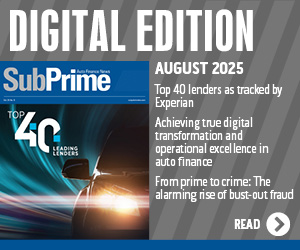Tough decision: Manage the book or grow the book?

In the executive boardrooms at automakers and finance companies, challenging conversations are being conducted. With sentiment intensifying about “plateauing” new-vehicle sales and institutions consistently looking for yield in light of where the Federal Reserve has kept interest rates, deciding whether to crank the incentive machine or buy a contract a little deeper down the credit spectrum to maintain originations on an upward trajectory are just some of the decisions to be made as we get deeper into 2016.
At the outset of the third quarter, Cox Automotive chief economist Tom Webb described auto financing by connecting it to the 10-year Treasury yield as well as stating that $12 trillion in sovereign debt trading at negative interest rates “is not normal.”
Webb continued, “That indeed is the major reason why about a year ago I wrote, ‘Reporters, financial analysts and regulators who are focusing their concern on auto lending are looking at the tree, a healthy tree. Meanwhile the forest, the global financial market, is encircled in flames and infected with parasites.’
“I’m afraid that the healthy tree might become infected,” he went on to say. “That’s not necessarily suggesting a collapse in the credit environment. But as I listen to lenders, and more importantly their investors, almost unanimously they are now saying we’re at the point in the cycle where as the saying goes, ‘You manage your book; you don’t grow your book.'”
As more finance companies share their second-quarter performance, it appears they haven’t just abruptly cut off originations. Webb acknowledged that the saying he referenced “could be wise advice,” but he countered it by noting activity in the wholesale market and what’s to come.
“We know what the coming wholesale volumes look like. The volumes will need to be retailed — the vast majority with financing attached. We need for the book to grow,” Webb said.
Growing that book could certainly be the pressure some finance companies are feeling, especially from the entities that control how much liquidity they have. Earlier in his career with organizations such as Wells Fargo, Equifax auto finance leader Lou Loquasto participated in the conversations about how institutions should proceed.
“It’s challenging because if you grow 15 percent per year for three or four years straight, it’s hard to go to your investors or to the holding company and say, ‘Well, the cycle is turning so we have to change expectations from 15 percent growth to 5 percent growth, but we’re still going to be very profitable.’ Those are conversations you have to have,” said Loquasto, who, like Webb, will be sharing analysis and observations during Used Car Week at the Red Rock Resort and Casino in Las Vegas from Nov. 14 to 18.
Loquasto described how finance company executives can discuss the possibility of backing off the origination accelerator without upsetting too many stakeholders.
“You have to be vigilant in telling the story, showing the data and backing up why there might not be as much growth coming as there had been in previous years,” he said. “You have to be disciplined in what you buy. You have to be able to tell the story that this is our area of the industry that we buy. We know it best. We have the best experience with it. It’s how our models work. I can grow more than I’m telling you but I’m going to have to get away from what I know best.
“There’s big dangers and plenty of examples in history where auto lenders were forced to grow more than they wanted to and went into areas where they didn’t have the data or have the experience, and it doesn’t always turn out well,” Loquasto went on to say.
A wide array of industry observers discussed earlier this week when July new-model sales figures began to arrive about how OEMs are pushing incentive figures higher in an effort to keep turns from “plateauing.” One analyst even went so far to say that current activity is putting the industry on an “unhealthy path.”
Kelley Blue Book analyst Akshay Anand noted, “It's clear the industry is plateauing, as we're now seeing signs of SUVs slowing down for several brands, while sedans continue to struggle.
“With incentives continuing to rise faster than (actual transaction prices) combined with the slowing growth, the industry is in a tricky spot,” Anand continued. “Still, sales are near all-time highs, and should continue to remain strong regardless of the flattened growth for the rest of 2016.”
AutoData Corp. reported that the new-vehicle seasonally adjusted annual rate (SAAR) in July was 17.88 million units versus 17.59 million units a year ago. Industrywide, 1,522,297 light vehicles were sold in July, compared to 1,513,901 in June, according to the AutoData information distributed by the American International Automobile Dealers Association.
“Several automakers struggled to increase volume last month, despite two extra sales days in July and rising incentives on many models,” said Kelley Blue Book senior analyst Karl Brauer. “The industry’s six-year sales streak is clearly plateauing, though plateauing at a rate above 17 million annual sales isn’t the worst place to be.”
So if the industry isn’t in the worst place it could be, what might be ahead? Loquasto closed with this thought with respect to the auto finance space.
“I think auto lenders will stick to their knitting better this time than the last run-up in the cycle,” he said. “I think we all remember what happened when lenders got away from their particular niche.
"I think when those conversations happen with shareholders, investors or holding companies, I think even those executives and stakeholders will still have the memory of what happened just recently. At least that’s my hope,” Loquasto added.


